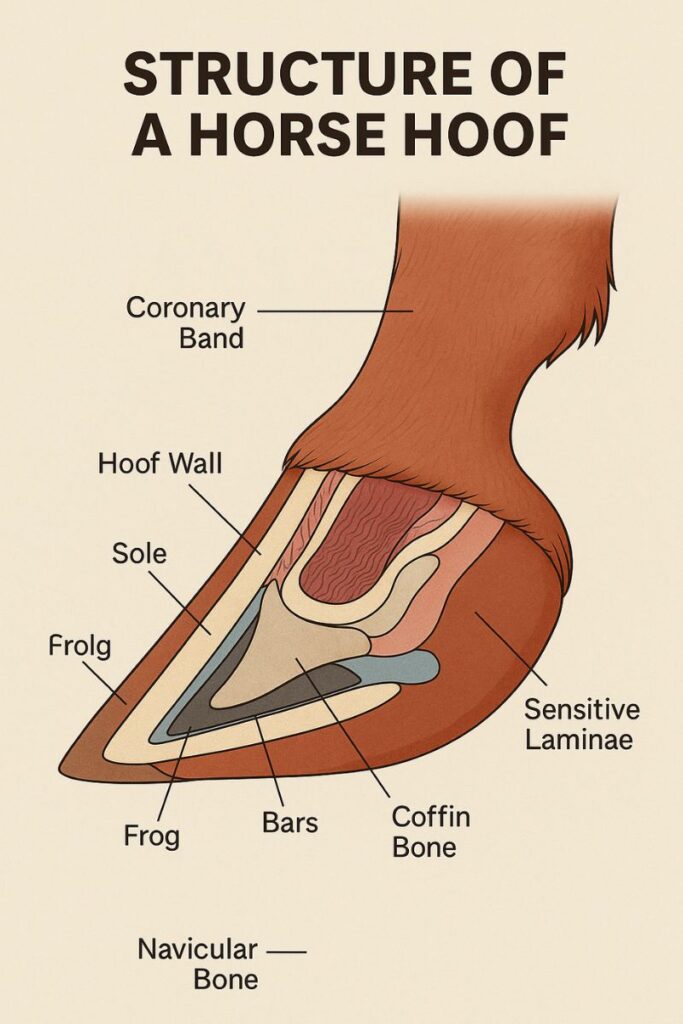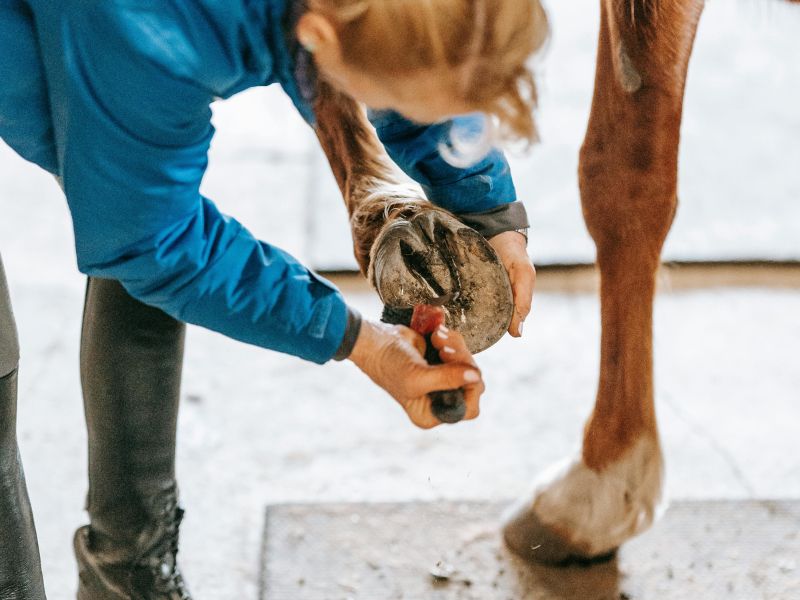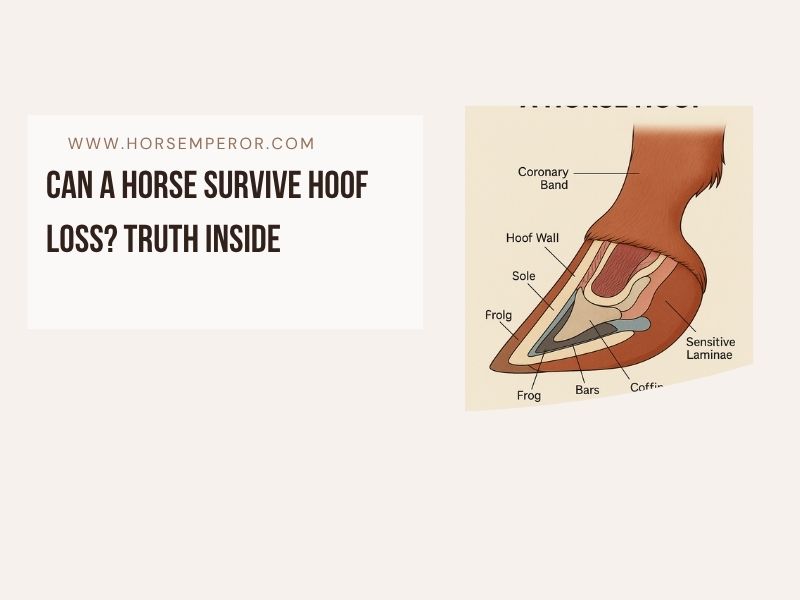Can a horse survive without a hoof? Because hooves are vital to a horse’s health. Owning a horse is a privilege that brings both pleasure and responsibility. As a guardian, you need to fulfill their basic needs like clean shelter, proper nutrition, and good mental wellness.
But hooves are also an essential component of their well-being that many owners tend to overlook. When equine caretakers manage the hooves improperly, it can lead to long-term damage or even irreversible damage that affects the entire body.
Domesticated horses face more hoof issues than their wild counterparts. In search of food and water, wild horses travel 10 to 20 miles daily across diverse terrain, which causes their hooves to naturally file down. This process, shaped by natural selection, makes their hooves genetically stronger.
On the other hand, domestic horses depend on humans and regular farrier visits for consistent care and trimming to keep their feet healthy.
In this article, we’ll explore hoof anatomy, the risks of hoof loss, rare case studies, and expert hoof care strategies.
Hoof Anatomy & Function
The horse hoof is made up of a few components which make the horse’s foot strong and steady.
- First is the hoof wall, which is made from keratin. It forms a tough layer on the outside that provides protection and support to the horse.
- Beneath the hoof wall is the sole, a concave surface that helps with shock absorption and adds another layer of shield for the inner parts.
- Inside the hoof is the digital cushion, a soft fatty pad that works like a shock absorber, especially during each hoof strike.
- The frog acts as a natural shock absorber and blood pump, sustaining circulation.
- Bars reinforce structural strength.
- At the core are structures like the coffin bone (also known as the pedal bone) and the navicular bone, which give the hoof its structure, help in movement, and keep the horse balanced.
- Then there are finger-like projections called sensitive laminae, which attach the coffin bone to the hoof wall. They also help in distributing weight and keeping everything stable.
- At the top of the hoof are the coronary bands, which create new tissue, feeding blood and promoting growth throughout the entire hoof.

These few components handle everything from weight bearing to circulation and flexibility. Healthy blood flow within the hoof is very important to keep the hoof strong and steady. Meanwhile, the tendons and joints of the horse help it move with agility and confidence.
So, it’s necessary to give proper hoof care, like regular trimming, shoeing, and a balanced diet to your horse. It just shows how important hooves are—because as every horse person knows, “no hoof, no horse.”
Why No Hoof = No Horse: Biomechanics & Physiology
No hoof, no horse is a biomechanical and physiological truth. This is because a functioning hoof ensures healthy gait, load distribution, and systemic balance. So without a hoof, the movement and life of a horse is compromised.
Let’s take a closer look at the medical conditions that prove the principle of ‘no hoof, no horse.’
- Acute hoof loss — conditions like trauma or amputation can cause sudden hoof loss, resulting in immediate instability and extreme pain.
- Chronic conditions like laminitis or founder can damage the laminae and disrupt hoof alignment. When the lamellae fail, it can cause radiographic displacement of the coffin bone.
- Metabolic disruptions, like Equine Metabolic Syndrome (EMS) or PPID (Cushing’s), can increase the risk of laminitis and trigger systemic inflammation.
- Some horses may develop compensatory injuries such as muscle atrophy, joint stress, or overloading of the opposite limb, which can lead to further health decline.
Can a Horse Survive Without a Hoof?
No, a horse cannot survive under normal or long-term circumstances without a hoof. However, there are some rare cases where horses have recovered after partial hoof loss or undergone surgical hoof amputation with prosthetic support (e.g., hoof boots or custom devices). But these types of cases require advanced veterinary care and usually result in limited mobility.
If a horse loses its hoof, it can lead to serious conditions like laminitis or white line disease. These issues can cause hoof capsule detachment, which exposes the sensitive internal tissues. At this stage, your horse needs immediate veterinary intervention, or euthanasia may become the only humane option.
Documented Cases: Hoof Loss & Prosthetics
Some universities and rescue centers have documented a few extraordinary examples:
- A miniature horse in Colorado underwent surgery and rehabilitation to receive a prosthetic hoof, which helped it regain partial function and mobility.
- In Argentina, engineer Nicholas Radzykewycz, working with the El Alpino Horse Rehabilitation Center, designed a custom prosthetic hoof within 24 hours using CAD and photogrammetry after a traumatic detachment.
- Veterinary literature also reports partial amputations in horses, usually at the mid-forelimb level, with recovery depending on the contralateral limb function and overall case complexity.
Common Hoof Conditions Leading to Severe Damage or Loss
- Laminitis / Founder: It is a serious condition where the soft tissue (called laminae) between the hoof wall and coffin bone becomes swollen and irritated. This swollen tissue can cause the coffin bone to rotate or sink, which is known as founder.
- According to research, laminitis affects between 1.5% to 34% of horses, and when these horses are treated in hospitals, they face six times higher risk of death.
- Strong pulses in the lower legs, hot hooves, and sawhorse stance (a painful stance) are the common signs of laminitis.
- NSAIDs (pain and inflammation medicine), cryotherapy (cold therapy to reduce damage), stall rest, and mechanical support like special shoes or pads are the treatments used for this disease.
- White Line Disease is a bacterial or fungal condition that separates the hoof wall and weakens the overall structure. If not treated properly, this condition can lead to hoof capsule failure.
- Thrush & Fungal Infections: Prolonged exposure to wet, unsanitary environments and attacks on the frog and sulci can lead to deep tissue damage.
- Abscesses, Cracks & Underrun Heels: This mostly happens because of poor trimming, compromised conformation, or neglect. It can build up structural issues over time and may lead to irreversible damage.
- Conformational Stress: Long toes, broken-back pastern-hoof alignment, and poor hoof-pastern axis are common causes of conformational stress. These issues can lead to serious conditions like navicular disease or coffin bone displacement. Research by Sharp et al. (2022) shows how hoof balance affects limb posture and injury risk.

Prevention & Hoof Maintenance Protocol
Daily Hoof Cleaning & Inspection
It is important to use a pick to clean out each hoof. Routine checking for heat, odor, cracks, discharge, or frog deformities is also necessary.
Proper trimming/shoeing is important to maintain optimal hoof shape. It also helps in proper weight distribution and prevents overgrowth.
Nutrition & Supplements
Key supplements include Biotin (20 mg/day), zinc, copper, and omega‑3 fatty acids—all support keratin formation and maintain hoof wall strength.
If laminitis risk is present, adopt a low-NSC (<10%), forage-based diet and avoid sugary grains.
Clean, Dry Environment & Regular Turnout
A clean environment and regular turnout are vital to minimize thrush risk and promote circulation within the hoof through movement. The horse should walk 5 miles per day on varied terrain.
Research & Real-World Outcomes
A 2014 study of 14 obese horses proved that laminitic horses showed improved outcomes with a mineral-balanced, low-NSC diet, and supportive hoof care.
A clinical case report described that foot instability managed using a wooden shoe helped in restoring partial function in severe pathologies.
In a study of horses with keratoma (a type of mass that grows inside the hoof wall), over 25 out of 30 horses showed good long-term recovery after having the mass removed while standing under sedation. Most of them were able to return to their normal level of activity afterward.
Conclusion
In very rare instances, a horse can survive without a hoof. But during recovery, there are high chances of chronic lameness and lifelong management. That’s why these stats and research prove that healthy hooves = healthy horse.
So yes, a horse can live without a hoof, or with a prosthetic hoof, but it is a journey full of challenges and difficulties.
References:
- Source: Colorado State – Survival of Miniature Horse through Prosthetic Rehabilitation
- Source: El Alpino – Engineer Nicholas Radzykewycz Designs Custom Prosthetic Hoof
- Source: Royal Veterinary College – Prevalence of Laminitis (1.5% to 34%) and Hospital Mortality Rates
- Source: UC Davis – Clinical Signs of Laminitis: Digital Pulse, Heat, and Sawhorse Stance
- Source: Sharp et al. 2022 – Study on Hoof Balance and Risk of Limb Injury
- Source: 2014 Study – 14 Obese Horses Improved with Low-NSC Diet and Balanced Minerals
- Source: Keratoma Research – 25 out of 30 Horses Recovered After Mass Removal Under Sedation
